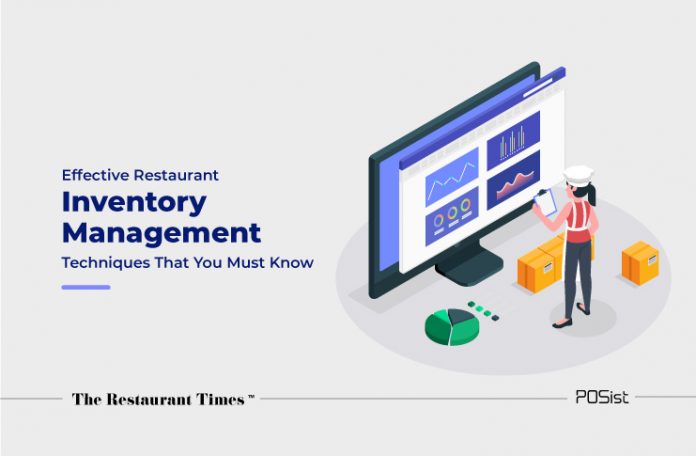A restaurant inventory comprises all the items or raw materials required to prepare dishes. As the volume of business increases, inventory management becomes a crucial part of restaurant operations. A restaurant inventory management system helps in tracking available stock and optimizing utilization Restaurant inventory management systems integrated with the restaurant POS can organize every aspect of stock management. It allows you to control and maintain a smooth flow of supply and boost your overall profit. This article explains how restaurants in the UAE can optimize their inventory using proven restaurant inventory management techniques.
Inventory Management Strategies For UAE Restaurants
Mentioned below are seven essential restaurant inventory management tips for UAE restaurants to control the costs and optimize restaurant operations.
1. Monitoring the Stock
Always track your existing stock before procuring fresh stock. Posist’s inventory management feature calculates the available stock at the beginning and end of the day. It calculates the remaining stock automatically and tallies it with the physical stock available.
The difference between actual consumption and minimum required stock is called variance. As some ingredients inevitably get used during food preparation, a variance between 2-5% is acceptable. Anything over this number is a matter of concern as it signifies pilferage and internal theft. An unfavorable variance percentage implies that raw materials are not being appropriately consumed, which ultimately results in a degradation of quality. Thus, variance and inventory management are essential factors in kitchen management.
2. Raw Material Management
Managing restaurant inventory consistently is mandatory to avoid wastage. Restaurant management software can help restaurant managers ensure better utilization of stock. Consider these points to ensure that your stock is efficiently used.
- Adopt a minimal stocking approach for your perishables and adopt the FIFO (First In First Out) method to avoid the wastage of perishables.
- Consider procuring seasonal products. With smart menu engineering, you can create a season’s special menu. This way, you will be able to attract customers with a new menu and avoid wastage.
- Invest in a robust inventory management software that allows you to set a reordering threshold for all your items. As soon as the ingredient reaches it, a reminder email is automatically sent to reorder that raw material in advance. This will also prevent the unfortunate situation of running out of supplies during operating hours. Real-time alerts are beneficial for the perishable items that need to be restocked frequently.
- Ensure that items are used based on a strict First in First out (FIFO) principle. Use the older stock first to prevent wastage.
3. Recipe Management and Costing
Standardization and recipe management is essential as it helps in curbing food costs and minimizing wastage. In a standard recipe, the quantity of each raw material used for preparing a dish is specified.
Record your recipes in the POS software, along with the portion sizes of each ingredient, to assess the estimated raw material requirement and food cost for each dish. Recipe management also leads to lower pilferage in the restaurant. For bigger restaurant chains, it maintains the same taste and consistency across all the outlets.
Restaurants can also get an estimate of the total recipe costs with the help of the recipe costing feature in POS solutions. The food cost should ideally be 30% of the selling price or menu price. This detailed information further helps in deciding the selling price of the menu items as well.
4. Central Kitchen Management
Chain restaurants or quick-service restaurants, generally have a central kitchen where the food is prepared and sent to the other outlets. The Multi-Store Management Module in most POS systems allows you to manage overall stock supplies, based on the outlets’ requirements.
This module also manages franchise outlets by receiving their requirements automatically. If an outlet runs out of a particular item, they can raise an indent or send a purchase order through their in-store POS terminal. The request is then received at the central kitchen, and the required stock is ultimately sent to the desired outlet.
When receiving the stock, restaurants must check and measure it for any possible damage or loss. The outlet receiving the stock can then generate a GRN (Goods Received Note), saying the stock has been received. In case the stock is lost or damaged, it can be mentioned in the GRN.
5. Shelf Life Management
Proper shelf-life management is an integral part of inventory management. Each item in the inventory has a defined shelf life. Where items such as rice can last for years, others like meat or poultry products have a far shorter shelf-life. Therefore, it is vital to manage the shelf life of perishables. For each raw material, specify usage details such as how long the material can be preserved and subsequently used, before needing replacement.
6. Roles and Permissions
Restaurant theft is a vice that cannot be controlled despite all the preventive measures. The variance feature in the POS system helps detect a discrepancy in the stock thus preventing your staff from pocketing the raw materials. However, you can also avoid this menace with Posist’s Roles and Permissions feature. With this feature, you can create specific role-based credentials for each employee., All user activities are automatically logged, and multiple users can be assigned different modules to maintain a check on the inventory.
7. Reporting and Analytics
Reporting and analytics are must-have features in restaurant inventory management software. The Sales and Raw Material Usage report, for example, can help in forecasting sales and strategizing better marketing campaigns. Profit and Loss reports are generated according to stock sale and consumption. The feature further helps in:
- Analyzing inventory trends- Restaurant operators can analyze inventory trends and make informed decisions, such as deciding the menu. You can generate detailed reports based on inventory consumption and gain essential insights related to raw materials.
- Keeping track of stock and maintaining accuracy- An appropriate list of the available supplies keeps a record of the daily and weekly usage
As UAE continues to focus more on food independence and economic diversification, more local chains are set to flourish and Inventory Management is going to be critical for the long term success of restaurants. Check if your restaurant POS is equipped with all these critical inventory management features for better stock management. To know more about choosing the right inventory management software for your UAE restaurant business, contact us!.



















